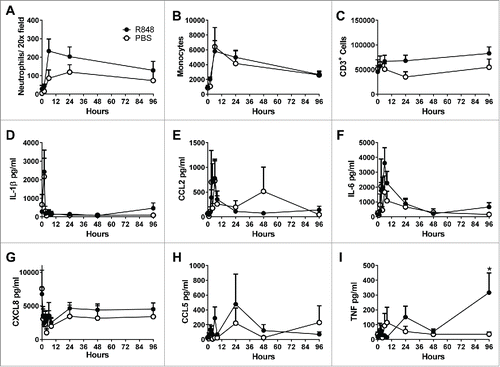Figures & data
Table 1. Dosing schedule
Figure 1. R848 is a potent mucosal adjuvant. Macaques were immunised intranasally with 200 μg KLH in combination with 500 μg of the adjuvants R848, Pam3SCK4 or chitosan, or 50 μg of TSLP or in PBS alone (n = 4 per group). Immunizations were administered at weeks 0, 4 and 8. KLH specific IgG was measured in plasma for all groups (A). Further analysis was performed for animals IE73, IE74, GK02 and IF53 from the R848/ KLH group and IE71 from the TSLP group. KLH specific ELISA were performed for IgG (C, E) and IgA (B, D, F) on plasma (B), nasal wash (C, D) and vaginal Weck-cels (E, F). KLH specific scIgA was measured in nasal samples (G). Relative coefficients of excretion (RCE) compared to albumin in nasal and vaginal samples (H). Data is presented as mean +/− SD of n = 4 animals (A, H) or individual animals (B-G).

Figure 2. R848 induces antibody responses after mucosal or systemic immunization. Macaques were immunised intramuscularly (IM, open symbols, A, B) or intranasally (IN, closed symbols, C, D) with 200 μg KLH in combination with 500 μg R848 (n = 4 per group). Immunizations were administered at weeks 0, 4 and 8. KLH specific ELISA were performed for IgG (A, C) and IgA (B, D) in plasma, data is presented as individual animals. Pooled data for each route is presented for IgG (E) and IgA (F), where each point represents mean of the n = 4 animals presented in A-D. * p < 0.05, ** p < 0.01 by multiple weighted t-test.

Figure 3. R848 induces local antibody responses after mucosal or systemic immunization. Macaques were immunised intranasally (A, E, I) or intramuscularly (B, F, J) with 200 μg KLH in combination with 500 μg R848 (n = 4 per group). Immunizations were administered at weeks 0, 4 and 8. KLH specific ELISA were performed for IgG (A, B, C) and IgA (E, F, G) in nasal lavage and IgG in vaginal samples (I, J, K). Relative coefficients of excretion (RCE) compared to albumin in nasal and vaginal samples (D, H, L). Data is presented as individual animals. Pooled data for each route is presented for each sample (C, F, I), where each point represents mean of n = 4 animals.

Figure 4. R848 induces mild local inflammation. Macaques were immunised intranasally with R848 or PBS and Nasal swabs collected at time 0, 1, 2, 3, 4, 6, 8, 24, 48, and 96 hrs. Nasal swabs examined for cellular infiltrates, neutrophils by cytospin (A), monocytes (B) and CD3 cells (C) by flow cytometry and fluids for cytokine/chemokine responses by CBA (D–I). Points represent n = 15 animals in the R848 group and 5 animals in the PBS control group +SEM, * p < 0.05 by multiple weighted t test.

Table 2. Antigen, adjuvant and route
